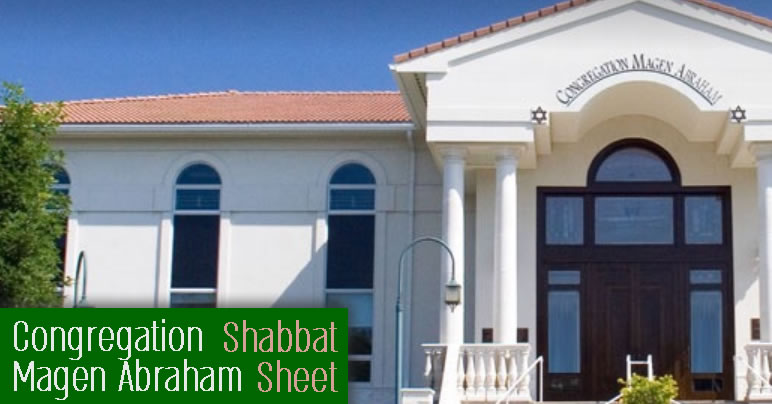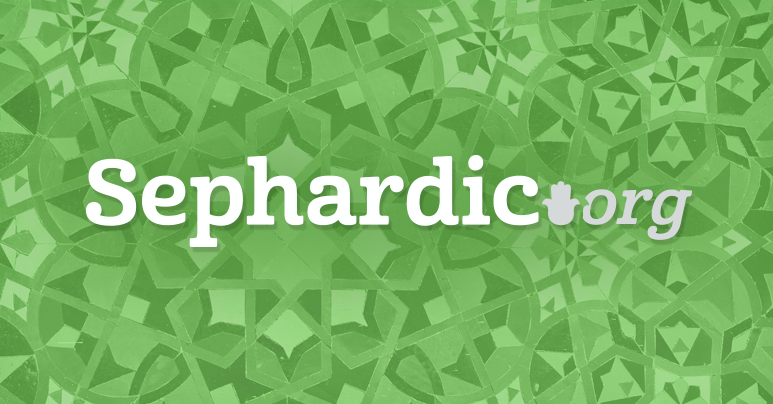
Congregation Magen Abraham
A Message from our Rabbi
“And Abraham drew near and said, ‘Will a sadik be destroyed together with a rasha?!’” (Beresheet 18:23) Rav Tzaddok teaches us that the first time a concept appears in the Torah, it defines its scope. Our first encounter with a notion tells us a lot about it. The first overt instance of tefillah (prayer) is the request of Abraham for Sedom to be saved. But, isn’t this a very odd introduction to tefillah in view of the fact that Abraham’s request is ultimately not granted, and Sedom is destroyed? Rabbi Zvi Kushelevsky explains that the Rambam writes that tefillah trains us to exercise our minds to realize that there is nothing besides Hashem. It accustoms us to focus on Hashem and block out our other issues. In short, tefillah is cleaving (devekut) to Hashem. This is why Abraham’s tefillah to save Sedom is the paradigm tefillah. For a person might think that the purpose of tefillah is to have one’s requests answered, to verbally articulate one’s shopping list of requests in the hope that they will be fulfilled. The fact that the first example of tefillah involved a request that was not granted accentuates the fact that the main part of tefillah is the cleaving itself. Tefillah is not about having requests answered; it is about the action of prayer, focusing on Hashem and temporarily zoning out all else in our lives.
Rabbi Reuven Semah
Eventually
The whole story of Abraham Abinu with Sedom is troublesome. Hashem says, “Will I hide from Abraham that which I am going to do?” [Beresheet 18:17] In other words, “Am I not going to tell him that I am about to destroy Sedom? I need to tell him!” Hashem knows what Abraham is going to do. It is that which in fact Abraham does – he is going to pray and bargain with Hashem NOT to destroy Sedom. So Hashem knows what the end of the story is going to be. He also knows that there are not 50 righteous people in Sedom, nor are there 40 nor 30 nor 20 and not even 10 sadikim in the city. So why give Abraham Abinu the opportunity to pray when Hashem knows that his prayers will be futile? What is the point? The answer is a lesson that we all need to learn because it is so prevalent. The lesson is that no Tefillah [prayer] ever goes to waste. The prayers that Abraham Abinu offered for Sedom may not have helped for that situation but somewhere, sometime, some place those tefillot helped. In fact, Rav Yonoson Eybeschutz in the Tiferet Yonasan says that this is similar to ma’aseh Abot siman l’Banim [the actions of the patriarchs foreshadow the actions of the descendants]. Just like the deeds of the fathers blaze the trail for similar deeds by their children in a more literal sense, so too there is a concept that when a city is in trouble or a community is in trouble, they go to a Sadik and request that he prays for them. Where does this come from? Rav Yonoson Eybeschutz says the original source for this custom is the action of Abraham in praying for Sedom. The patriarch Abraham instituted the concept that a Sadik can pray for a city in trouble to save them from their plight. This answers a question. In Tefillat Neilah, at the very end of Yom Kippur, when we pull out all stops, we invoke the following words: “Heaven forbid from You to do this thing, to kill the righteous along with the wicked. The Judge of the entire world will not do such a thing.” Now consider something: Is this a wise prayer to invoke at Neilah? These words are immediately recognizable as being lifted from the prayer of Abraham Abinu for Sedom. However, it did not work then, so why are we using the same (failed) formula: Heaven forbid from you... (Halilah Lecha..)? The answer is that it DID work the first time. It may not have worked for the people of Sedom because they did not deserve it — but eventually it worked. It worked – according to the Tiferet Yonasan – in that now all Sadikim can pray for communities in trouble. And it worked because sometime, someplace – it did have an impact. In fact, we can say that this is the underlying message of the sequence of pesukim: “Am I going to hide from Abraham that which I am going to do? [Beresheet 18:17] For Abraham is going to become a great and mighty nation. [ibid. 18:18] What does pasuk 18 have to do with pasuk 17? It does not seem to belong in this monologue. What does the fact that Abraham will in the future become a great and mighty nation have to do with the price of tea in this discussion? The answer is that Hashem is saying the following: I am not going to hide from Abraham what I am about to do, and I know that Abraham is going to pray, and I know that his prayers at this juncture are not going to help Sedom. However, a great and mighty nation will descend from Abraham. I know that this nation is going to need those prayers at various times in the future. Let him verbalize those prayers now for the welfare of his future descendants. There are many more stories of this kind, where Tefillot of grandparents or even parents which seemingly went to waste, helped – two or even three generations later – as all Tefillot do. (Rabbi Yissocher Frand)
Our Akedat Yitzhak
“And it came to pass after these things, that G-d tested Abraham, and He said to him, “Abraham,” and he said, “Here I am.” And He said, “Please take your son, your only one, whom you love, Yitzhak, and go away to the land of Moriah and bring him up there for a burnt offering on one of the mountains, of which I will tell you.” (Beresheet 22:1-2) Is it too irreverent to ask about the current and daily relevance of Akedat Yitzhak? There it is in our Siddur to be read every day. What is it telling the “you” and “me” of the world? Sure Abraham Abinu, without question, passed the supreme test of history. That was the height of the heights and yet we find ourselves now as amateur climbers at the base of a tall mountain, gazing with awe in search of a peak at the peak which is shrouded in mysterious cloud cover. How does that loftiest of all accomplishments translate to our ordinary struggles? A 7th grade boy was begging me last week to find out how he could get a custom filter fitted for his Smart Phone. On his own he went to a designated location where some volunteer tech guys could adjust his phone and remove temptation from his reach. It was heroic and perhaps on his level not less than Abraham Abinu giving up his beloved son. Taking a bold step in the right direction, curbing a debilitating habit, giving up on what we love for something greater is a not just a mini-replica, it’s our Akedat Yitzhak! (Rabbi Label Lam)
Puzzles
It takes a great deal of patience to complete a 1000-piece jigsaw puzzle. Not only are there many pieces to handle, but the pieces are cut to look very similar to each other in size and shape. My best friend loves to do puzzles and has completed a great variety of them. His “artwork” is displayed in beautiful frames on the walls of his home. Personally, I don’t have what it takes to confront the challenge of a jigsaw puzzle. But I do enjoy watching puzzles develop from a mess of disjointed pieces into a beautiful, completed picture. My fascination is fueled as I come back to the table at intervals and observe the progress the puzzle doer has made since my last viewing. As each interlocking piece is placed in its designated location, a clear picture develops – until all one thousand pieces are joined into a work of art. Life is certainly a puzzle. The more we learn and the more we consider the ways of Hashem, the more questions and inconsistencies we discover. But with maturity, we start to understand that although the incomplete picture is hard to fathom, there is a picture that will be beautiful when all the pieces are in place. When you just don’t understand “why,” think for a moment about all the simple things that you understand as an adult which baffled you as a child. Notice that there is a way to understand the puzzle. Realize that you do see more of the picture day by day, but that until it is complete, some missing, vital pieces may prevent the puzzle from making any sense. This thought process only takes a minute, but it will give you the calm, patient approach to life that will shore up your emunah – faith in the beauty of Hashem’s completed puzzle. (One Minute With Yourself – Rabbi Raymond Beyda)
Community Synergy
“If there is a cut in the skin anywhere in the body, the entire body reacts automatically to deal with the threat. To minimize leakage of precious blood from the wound, tiny cells called platelets are routed from all parts of the circulatory system to the site. Platelets are colorless bodies; whose sticky surface lets them form clots to stop bleeding.” Whenever one needs any type of support, our wonderful community has many groups to assist. We should all thank Hashem for the Community Synergy to help patch up wounds of community members in need. (Norman D. Levy, based on Rabbi Miller’s teachings with permission from Simchas Hachaim Gedola Bais Yisrael) Bittersweet
One never knows in this world whether an omen is good or bad. Jewish tradition teaches us that “from the strong (bitter) comes the sweet” (Shoftim 14:14) “A blessing in disguise,” is not merely a sweet-sounding cliché, it is a lifelong perspective that should be ever-present and never forgotten. This story is a perfect example of this. Sharon and Ben were students of Rabbi Goldwasser’s and had kept close ties with him over the years. The Rabbi was elated when they came to him and revealed that they were engaged to be married. Before they would accept the traditional wishes of mazal tob, they made Rabbi Goldwassser promise that he’d officiate at their wedding. He enthusiastically agreed. As they left his home, he thought, “What a perfect couple; both so giving and sensitive.” There was no question that their marriage would be a wonderful asset to the entire community. Approximately eight weeks later, Rabbi Goldwasser received a frantic phone call from Sharon. In a trembling voice she related the following: Ben, being athletic, could never resist the invitation to play a game of basketball. He had been invited by one of the local amateur teams to substitute for a player who was unable to make the game. As Ben was going in for a lay-up shot, he tripped, fell over and hit his head on the hardwood gym floor. Ben’s head split open and he was unconscious. Immediately, he was rushed by ambulance to the nearest hospital. It was fortunate that that evening some highly skilled doctors were on call at the moment Ben was wheeled in. The doctors gave their immediate attention to Ben. While examining him, they discovered something quite unbelievable - Ben had a growth in the back part of his head which needed to be removed at once! Following hours of surgery, the chief of surgery emerged flashing the victory sign., Baruch Hashem, the operation had been a success. As the days passed, Ben’s recuperation went excellently. The doctors unanimously agreed that had the accident never taken place, the growth would have surely progressed undetected and taken Ben’s life. It has been sixteen years since that fateful encounter of hashgachah and din on the basketball court. An additional six chairs have been added around the table to accommodate Sharon and Ben’s wonderful children. To this very day, Sharon and Ben prepare a feast of thanksgiving each year on the exact date of Ben’s fateful fall. (Living on the Edge)
The magnificent Congregation Magen Abraham is situated in an area of West Long Branch New Jersey, which formerly was a commercial asparagus farm. We now Baruch Hashem, have a beautiful building. We have a grand Social Hall, and catering facilities. Rabbi Mordechai Dabbah helps Rabbi Semah teach our community’s beautiful Minhagim and Halachot to our adult men and ladies and our young children. Our Synagogue now has five Minyanim each Shabbat morning, catering to every age group. Our Youth Program Minyan is now attended by almost one hundred children every Shabbat.








